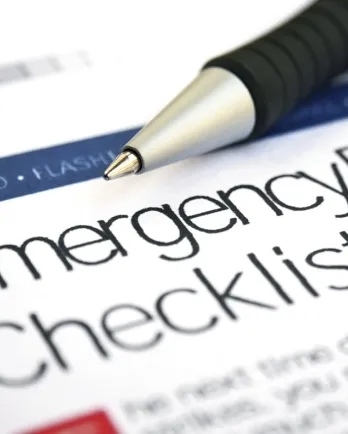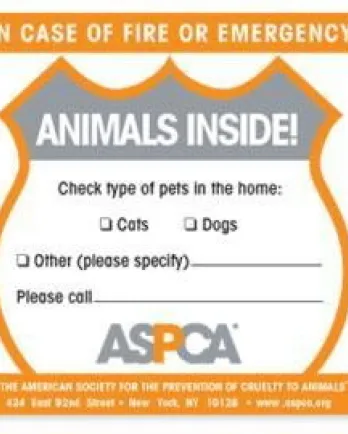A Guide to Emergency and Disaster Preparedness for Dogs by Yvone Kon
If Superstorm Sandy taught us anything, it's that natural disasters happen, happen quickly, and can have devastating and long-term effects. The hurricane-force winds, flooding, and loss of power and other essential services caused an estimated $68 Billion in damages and killed two people. The animal casualties were much higher. In order to keep all members of your family safe and prepare for another such disaster or other emergency, it is essential to have a Emergency and Disaster Preparedness Plan in place not just for you, but also for your pets.
Create an Emergency and Disaster Plan
If you need to evacuate your home, where would you go with your dog? Does the Red Cross Shelter accept pets? Who would you leave your dog with if you couldn't find a shelter for you both? Whether it is a hurricane, tornado, earthquake, flood, or fire, you will have little time to act once disaster strikes. Now is the time to start planning how you will take care of your dog during the next natural disaster, not a day or two before the next one is forecast.
Here are some steps you can take to make sure the four-legged members of your family are ready in the event of a natural disaster or other emergency.
Create an Emergency and Disaster Folder for Paperwork
- Make sure you have proper identification for all your pets, including tags, as well as a microchip. Keep copies of all paperwork in an Emergency and Disaster Kit, along with the phone number of the microchip company. If a dog goes missing, some microchip companies/plans will alert shelters in the area to look for your dog.
- Check that your dog(s) are up to date on their shots/vaccinations. Keep copies of the paperwork in your Emergency and Disaster Kit. Many safe havens for you and your dog will only accept pets if they have been vaccinated, so this proof may be essential to keep your dog with you. Some will accept dogs if they are muzzled, so it may be prudent to invest in this crucial piece of equipment just in case. Be sure to practice using it with your dog before it is needed.
- Keep current copies of the prescription medications your dog takes on a regular basis.
- Make a list of your dog's health needs, any behavioral issues, and your veterinarian's phone number, in case your dog needs to be separated from you during evacuation and cared for by emergency personnel or a kennel.
- Include a current photograph of your dog, along with a current photograph of your dog with any of the family members or friends who are authorized to pick your dog up in the event he or she ends up in an animal shelter. The photograph might be the only way the shelter can authorize someone else to leave with a pet.
Do Your Research and Find a Safe Haven
Due to state and local regulations, many Red Cross shelters cannot permit any animals, except for service animals. In the event of a disaster, your community may set up a temporary rescue area for pets. However, you should be prepared to make alternative arrangements for your pets.
- Find out which animal shelters/kennels provide emergency shelter in the event of a natural disaster. Ask your veterinarian for referrals.
- If you don't want to leave your dog in a shelter or kennel, research hotels or motels along your evacuation route that accept pets. You can research dog friendly accommodation at BringFido.com, and DogFriendly.com.
- If a shelter/kennel or a hotel/motel is not possible, ask a family member or friend in advance if they will be your dog's emergency caregiver in the event of such a situation. It is important to choose someone who likes animals and has some experience taking care of them. Ideally, you should choose someone who has already met your dog and had good interactions with him or her in the past.
Create Your Emergency and Disaster Kit
- Choose a bag large enough to accommodate all the food, water, and essentials for your pets, but one that is easy enough to transport while you are traveling with them. A large backpack would be perfect for a single dog, or a duffel bag on wheels would be good for someone with multiple dogs.
- Be sure to include at least seven days worth of bottled water and food for EACH pet, along with collapsible food dishes, paper towels, dish soap, and bags for trash. Particularly with a senior dog, it is important to get the same food he usually eats. Dogs are sensitive to food changes unless done very gradually. No need to add more stress to your dog in an already stressful situation. Remember to rotate food every six month so the food in your kit is always fresh.
- Add a dog first-aid kit and a guide book for basic first-aid procedures. Common first-aid supplies for dogs are: gauze, nonstick pads or strips of clean cloth, veterinary tape, topical antibiotic, eye wash solution, tweezers, an eye dropper and syringe (without needle), and a rectal thermometer.
- Include two weeks worth of any medication/supplements your dog takes. Be sure to rotate medications every six months to one year to make sure medications don't go bad.
- Include comfort items for your dog, such as treats, chew toys, a favorite blanket, stuffed animals, or toys. If your senior dog has arthritis, etc., be sure to remember to take his bed and/or blankets to make him as comfortable as possible.
- An extra collar or harness and leash.
- Add your Emergency and Disaster Folder to the kit.
- Store your kit in a convenient location that can be easily accessed in the event of an emergency. Show any emergency caregivers where you keep the kit.
Evacuation
NEVER leave your pets behind or outside during a disaster. If it isn't safe for you to stay, it is not safe for them either. If evacuation has been recommended, evacuate early. Sometimes, those under mandatory evacuation orders are forced to leave pets behind. When a natural disaster has been forecast, do not leave your dog at home alone, even for a short period of time, as you may be prevented from returning. During an evacuation, always keep your dog on a leash or in a carrier, as the sights, sounds, and smells of an approaching storm or fire may cause your dog to become frightened and unpredictable. In case you are separated from your dog during the evacuation, make sure that your dog is wearing an ID tag with name, phone number, and any urgent medical needs; write the same information on your dog's carrier.
Shelter In Place
Not all disasters or emergency situations require evacuation. In areas with heavy tornado activity, there is usually only enough warning to get to a basement or other safe room before disaster strikes. An essential part of your Pet Disaster Plan is to decide how you will handle your pets if you need to shelter in place.
Designate a safe room where you and your family and pets will go in the event of a natural disaster. Choose a room that has access to water, no windows, and is easy to keep clean. An interior room is best, with no walls to the outside of the house. If that's not possible, other good choices are utility rooms, laundry rooms or basements. If you have ample warning, fill up any tubs and sinks with water so you have a fresh supply available. If flooding is a consideration, go to the highest point in your house. Choose one person to be responsible for making sure the pets make it to the safe room. If you have multiple pets, assign a different pet to each family member. If you have time, leash your dog(s).
Keep Your Dog Comfortable
Any disaster or emergency that forces you and your dog to evacuate will be stressful on everyone. If you have a senior pet, he will feel this stress even more acutely. A loud shelter buzzing with activity and hundreds of strangers and unusual smells is a far cry from the comfy sofa and warm pillows your dog may be used to. As mentioned above, when dealing with a senior dog, do whatever you can to provide as many of the comforts of home. Also, try to keep to your dog's regular routine. Make sure you feed and walk him as close to his regular time as you can. Don't forget to try to make some time for play (but don't overdo it!), and naps, too. Just remember, your dog is going through this scary situation with you.
The Unthinkable
As a parent, whether to a human child or an animal, one of our worst fears is having something terrible happening while we are away and not being able to get to our kids. As hard as it is to think about, it is crucial to prepare for this situation to make sure your dog is taken care of in the event of a natural disaster or emergency. In the event that something happens that prevents you from getting back home to your pets, you need to make sure someone can get there to check on them, give them food and water, take them out, or remove them completely if the situation is dangerous or drags on. You can ask your emergency caregiver to take on this important task as well. If they agree, be sure to give them an extra key to your house. Go through how to get inside and take care of your pets, step by step. If you keep your dog(s) in a crate while you are gone, be sure to show your caregiver where in the house they are, what items you keep in the crate with them, where you keep their food, how much and how often to feed them, and where you keep their dishes, collars and leashes. You should also show them where you keep your Emergency and Disaster Kit.
If the natural disaster or emergency is so severe that even your emergency caregiver isn't able to get to your pets to take care of them, you'll want to make sure emergency workers know your pets are inside and need rescuing. Use this online form to order a free Pet Safety Pack from the ASPCA. It includes a window decal to affix to a window on the front of your home to let emergency workers know how many pets are inside.
As the old saying goes, “if you fail to plan, plan to fail.” Follow these steps and you will have a good plan in place to keep your four-legged family members safe and sound.
The information presented by The Grey Muzzle Organization is for informational purposes only. Readers are urged to consult with a licensed veterinarian for any issues relating to their pet's health or well-being or prior to implementing any treatment.
The Grey Muzzle Organization improves the lives of at-risk senior dogs by providing funding and resources to animal shelters, rescue organizations, sanctuaries, and other nonprofit groups nationwide.




